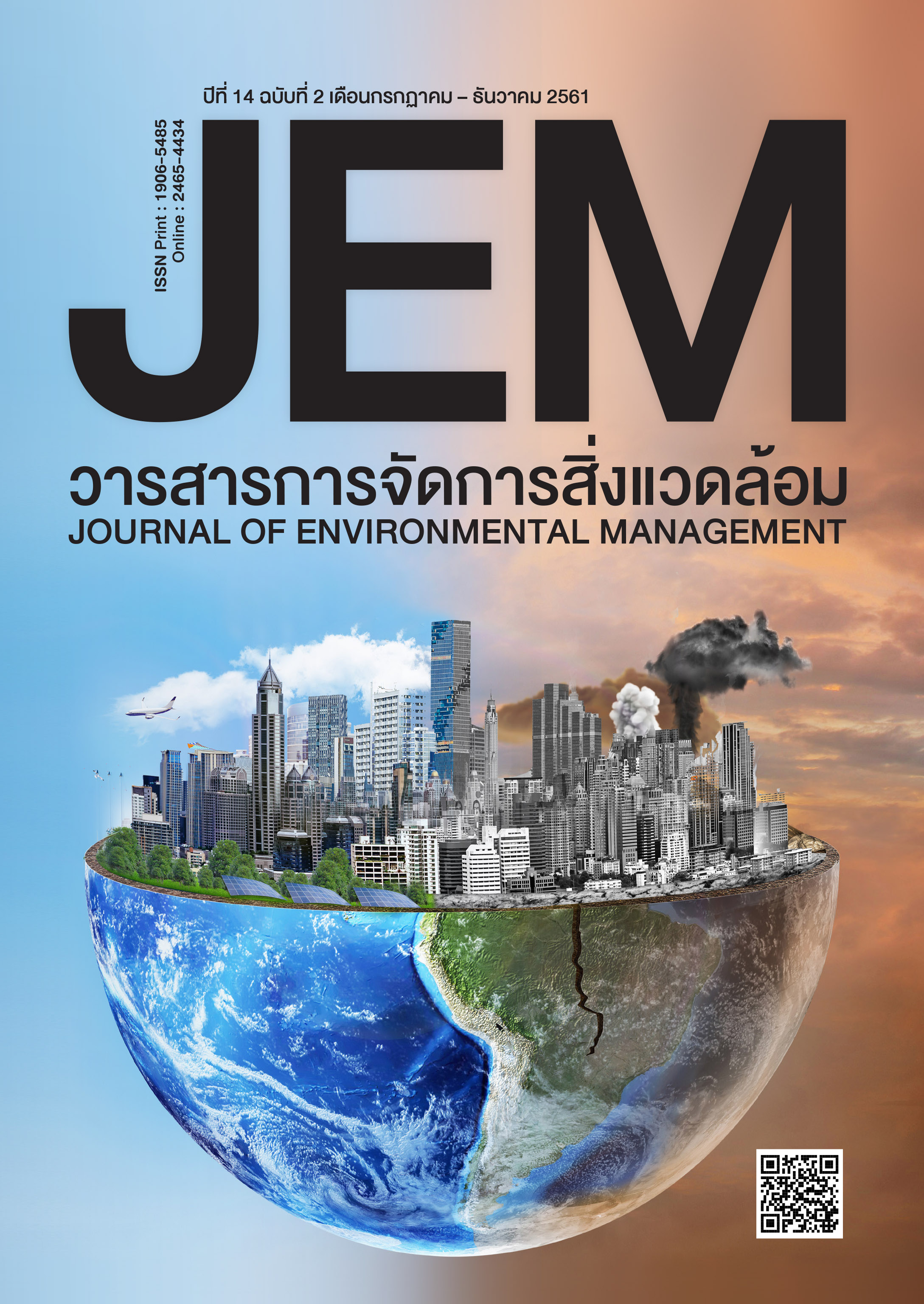การพัฒนาตัวชี้วัดที่เหมาะสมขององค์กรปกครองส่วนท้องถิ่นในการดำเนินงานเมืองอุตสาหกรรมเชิงนิเวศ DEVELOPMENT OF APPROPRIATE INDICATORS OF LOCAL ADMINISTRATIVE ORGANIZATIONS IN IMPLEMENTING THE ECO INDUSTRIAL ESTATE
DOI:
https://doi.org/10.14456/jem.2018.8คำสำคัญ:
องค์กรปกครองส่วนท้องถิ่น, เมืองอุตสาหกรรมเชิงนิเวศ, ตัวชี้วัดสำคัญ, โรงงานอุตสาหกรรม, สิ่งแวดล้อมบทคัดย่อ
การศึกษาครั้งนี้มีวัตถุประสงค์เพื่อพัฒนาตัวชี้วัดที่เหมาะสมขององค์กรปกครองส่วนท้องถิ่น (อปท.) ในการพัฒนาไปสู่เมืองอุตสาหกรรมเชิงนิเวศ ทำการศึกษาแบบผสมผสานระหว่างการศึกษาเชิงคุณภาพและเชิงปริมาณ เริ่มต้นจากการสัมภาษณ์เชิงลึกและการสนทนากลุ่ม จากนั้นทำการศึกษาแบบเทคนิคเดลฟาย โดยให้ผู้เชี่ยวชาญจำนวน 12 คน พิจารณาจำนวน 3 รอบ จากนั้นทำการศึกษาเชิงสำรวจในกลุ่มอปท.จำนวน 4 แห่งและผู้ที่มีส่วนเกี่ยวข้องในพื้นที่จำนวน 237 คน วิเคราะห์ข้อมูลโดยการวิเคราะห์องค์ประกอบแบบสำรวจและการวิเคราะห์องค์ประกอบแบบยืนยัน ผลการศึกษาพบว่า ตัวชี้วัดสำคัญประกอบด้วย 8 มิติ และ 50 ตัวชี้วัด โดยประกอบด้วย ระบบการบริหารจัดการในองค์กร การบังคับใช้มาตรการทางกฎหมาย การสร้างเครือข่าย ระบบข้อมูลข่าวสาร การสื่อสารสาธารณะ การพัฒนาองค์ความรู้ การมีส่วนร่วม และ การพัฒนาคุณภาพชีวิต โดยค่าน้ำหนักขององค์ประกอบ (factor loading) มีค่าอยู่ระหว่าง 0.60-0.90 การวิเคราะห์องค์ประกอบแบบยืนยันพบว่า ค่าไค-สแควร์ไม่มีนัยสำคัญทางสถิติ (chi-square=8.33, df=7, p-value=0.54) ความสอดคล้องระหว่างโมเดลที่ได้กับข้อมูลขององค์ประกอบ (Standardized Root Mean Square Residual : Standard RMR) มีค่า 0.02 ความสอดคล้องของโมเดลกับข้อมูลเชิงประจักษ์ (Root Mean Square Error of Approximation : RMSEA) มีค่า 0.02 ค่าความสอดคล้องของโมเดล (Goodness of Fit Index : GFI) และความสอดคล้องของโมเดลเชิงเปรียบเทียบ (Comparative Fit Index : CFI) มีค่า 0.99 และ 0.99 ซึ่งแสดงว่าโมเดลมีความกลมกลืนกันดี
เอกสารอ้างอิง
2. Andreas Koenig, W. A. (2005). The Eco-Industrial Park Development A Guide for Chinese Government Officials and Industrial Park Managers, 10-13.
3. Bureekul, T. (2007). Participation: concepts, theories, and processes [In Thai]. Bangkok: Pranakorn Company Limited.
4. Burger, J. (2008). Personality (7th ed.). Singapore: Thomson Wadsworth.
5. Chadcham, S. (2004). Confirmatory factor analysis [In Thai]. Journal of Educational Research and Measurement, 2(1), 15-42.
6. Chaijareanwatana, B., & Lee, B. (2001). Indicators of Good Governance [In Thai]. Bangkok: King Prajadhipok’s Institute.
7. Eak-Natapot, C. (2009). Appropriate waste management for primary care units Case study: Lamlukka District, Pathumthani Province [In Thai]. Master of Public Health Thesis Faculty of Health Sciences, Thammasat University.
8. Hair, J., Blak, W.C., Barbin, B.J., Anderson, R.E., & Tatham, R.L. (2010). Multivariate data analysis. New Jersey: Upper Sandle River, Prentice Hall.
9. Hergenhahn, B., & Olson, M. (2007). An introduction to theories of personality (7th ed.). New Jersey: Pearson Education.
10. Jarusombat, S. (2008). Environmental policy and management [In Thai]. Bangkok: Thammasat University Press.
11. Kaiwan, Y. (2008). Business Research [In Thai] (1st ed.). Bangkok: Bangkok Medea Center.
12. Kanoran, U. (2004). Effectiveness of Solid Waste Management in Subdistrict Administrative Organization: A Case Study of Samphran Subdistrict Administrative Organization, Nakhon Pathom Province. Bangkok: Ramkhamhang University.
13. Natural Resources and Environmental Policy and Planning Office, Ministry of Natural Resources and Environment. (1999). A Guide for the Management of Natural Resources and the Environment of the Local Government Organization [In Thai]. Bangkok: Shinawat Publishing.
14. Office of the Decentralization Commission, Office of the Prime Minister. (2002, June 25). Meeting of Subcommittee on Finance and Personnel 4/2002 [In Thai]. Meeting Room 501, Command Building, Government House, Bangkok.
15. Onibokun, A.G. (1997). Governing and urban waste in Africa’s cities. Witwatersrand University Press, Johannesburg, South Africa. Page B. Communities as the agents of commodification: The Kumbo Water Authority in Northwest Cameroon. Geoforum 2003, 34(4), 483–98.
16. Pattamasiriwat, D., & Rayanakorn, K. (2009). To drive local government organizations for good public administration [In Thai]. Bangkok: TQP Company Limited.
17. Poung-Ngam, G. (2005). Local Government of Thailand : New Principles and Dimensions in the Future [In Thai]. Bangkok: Vinythai.
18. Schumacker, R.E., & Lomax, R.G. (2010). A beginner’s guide to structural equation modeling. New York: Routledge.
19. Steven, J.P. (2009). Applied multivariate statistics for the social sciences. New York: Routledge.
20. Surit, P., Tananpa, R., Sittitum, U., Sompaojeen, S., Mirasena, S., & Jariya, W. (2017). Roles of industries in Environment Surveillance Implementation: A case Study in The Northern Industrial Estate, Lamphun [In Thai]. Journal of Environmental Management, 13(2), 49-57.
21. Tabachnick, B.G., & Fidell, L.S. (2001). Using multivariate statistics. Boston: Pearson Education Company.
22. Teeravaraprug, J., & Podcharathitikull, T. (2016). Factors for Success in Eco-Industrial Town Development in Thailand. International Science Index, Economics and Management Engineering, 10(7), 2345-2349.
23. Viratchai, N. (1994). Linear Structural Analysis: Statistical Analysis for Social Science Research and Behavioral Sciences [In Thai]. Bangkok: Chulalongkorn University.
24. Wu, J., Chang, I. S., Bina, O., Lam, K. C., & Xu, H. (2011). Strategic environmental assessment implementation in China — Five-year review and prospects. Environmental Impact Assessment Review, 31(1), 77–84.



